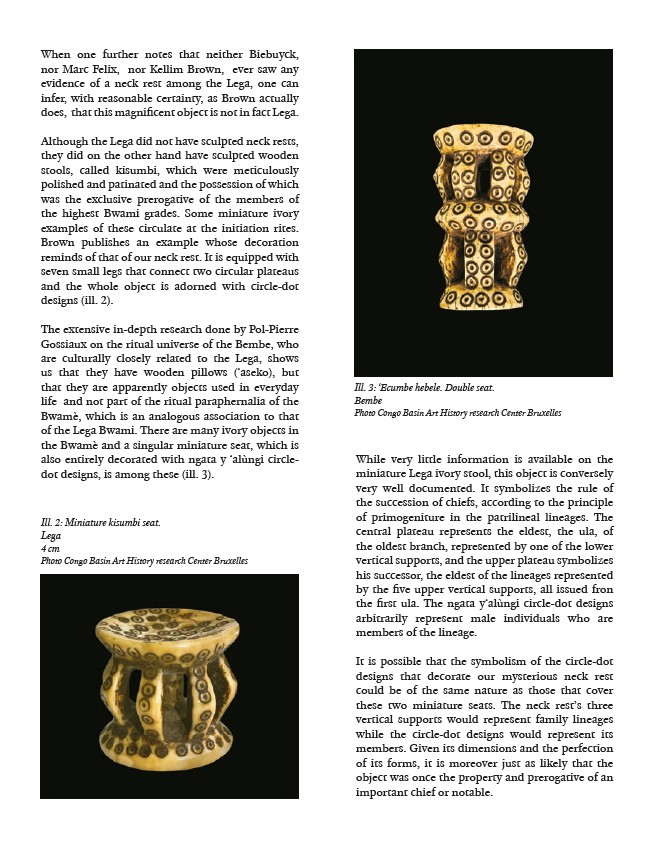
While very little information is available on the
miniature Lega ivory stool, this object is conversely
very well documented. It symbolizes the rule of
the succession of chiefs, according to the principle
of primogeniture in the patrilineal lineages. The
central plateau represents the eldest, the ula, of
the oldest branch, represented by one of the lower
vertical supports, and the upper plateau symbolizes
his successor, the eldest of the lineages represented
by the five upper vertical supports, all issued fron
the first ula. The ngata y‘alùngi circle-dot designs
arbitrarily represent male individuals who are
members of the lineage.
It is possible that the symbolism of the circle-dot
designs that decorate our mysterious neck rest
could be of the same nature as those that cover
these two miniature seats. The neck rest’s three
vertical supports would represent family lineages
while the circle-dot designs would represent its
members. Given its dimensions and the perfection
of its forms, it is moreover just as likely that the
object was once the property and prerogative of an
important chief or notable.
Ill. 2: Miniature kisumbi seat.
Lega
4 cm
Photo Congo Basin Art History research Center Bruxelles
Ill. 3: ‘Ecumbe hebele. Double seat.
Bembe
Photo Congo Basin Art History research Center Bruxelles
When one further notes that neither Biebuyck,
nor Marc Felix, nor Kellim Brown, ever saw any
evidence of a neck rest among the Lega, one can
infer, with reasonable certainty, as Brown actually
does, that this magnificent object is not in fact Lega.
Although the Lega did not have sculpted neck rests,
they did on the other hand have sculpted wooden
stools, called kisumbi, which were meticulously
polished and patinated and the possession of which
was the exclusive prerogative of the members of
the highest Bwami grades. Some miniature ivory
examples of these circulate at the initiation rites.
Brown publishes an example whose decoration
reminds of that of our neck rest. It is equipped with
seven small legs that connect two circular plateaus
and the whole object is adorned with circle-dot
designs (ill. 2).
The extensive in-depth research done by Pol-Pierre
Gossiaux on the ritual universe of the Bembe, who
are culturally closely related to the Lega, shows
us that they have wooden pillows (‘aseko), but
that they are apparently objects used in everyday
life and not part of the ritual paraphernalia of the
Bwamè, which is an analogous association to that
of the Lega Bwami. There are many ivory objects in
the Bwamè and a singular miniature seat, which is
also entirely decorated with ngata y ‘alùngi circledot
designs, is among these (ill. 3).